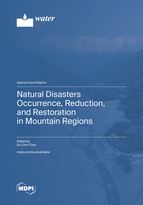Natural Disasters Occurrence, Reduction, and Restoration in Mountain Regions
A special issue of Water (ISSN 2073-4441). This special issue belongs to the section "Hydrology".
Deadline for manuscript submissions: closed (31 March 2023) | Viewed by 61533
Special Issue Editor
Interests: sediment transport; soil erosion and scour; dam breach; landslides; vegetation restoration; eco-hydrology; disaster mitigation
Special Issues, Collections and Topics in MDPI journals
Special Issue Information
Dear Colleagues,
Mountain regions are critical because of their diverse geological conditions, dynamic changes, and the multiple natural hazards that often occur. Mountains are high-risk environments that can experience a variety of natural hazards, since initiated hazards often trigger secondary, cascading hazards, having a significant impact not only on the area of occurrence but often also on up- and downstream regions. High economic losses and human casualties are caused by geophysical- (rockfalls, earthquakes, and volcanic activities), hydrological- (floods, avalanches, and dammed-lake outbursts), and sediment-related hazards (landslides, driftwood, debris/mud flows, and surface erosion). Under the impacts of global warming and climate change the spatiotemporal patterns of rainfall and other weather events have become more unevenly distributed, often with a more extreme magnitude and/or intensity of events. The complexity of mountain regions in addition to the continued changes in the climate and land use have made it more challenging to predict mountainous hazards and their impacts on communities. Based on the countless efforts made worldwide on natural hazards in mountain regions, tight international collaboration is strongly required to answer questions related to the causes of disasters, the monitoring of hazardous phenomena, predicting disasters, and the effective reduction of hazardous consequences.
Related Conference:
INTERPRAEVENT International Symposium 2022 has teamed up with this Special Issue. The oral presenters are encouraged to submit manuscripts to this SI; if accepted, the papers will be published in Water and collected in the INTERPRAEVENT proceedings.
For more information about the INTERPRAEVENT Symposium, visit the conference website: https://interpraevent2022.nchu.edu.tw/
Prof. Dr. Su-Chin Chen
Guest Editor
Manuscript Submission Information
Manuscripts should be submitted online at www.mdpi.com by registering and logging in to this website. Once you are registered, click here to go to the submission form. Manuscripts can be submitted until the deadline. All submissions that pass pre-check are peer-reviewed. Accepted papers will be published continuously in the journal (as soon as accepted) and will be listed together on the special issue website. Research articles, review articles as well as short communications are invited. For planned papers, a title and short abstract (about 100 words) can be sent to the Editorial Office for announcement on this website.
Submitted manuscripts should not have been published previously, nor be under consideration for publication elsewhere (except conference proceedings papers). All manuscripts are thoroughly refereed through a single-blind peer-review process. A guide for authors and other relevant information for submission of manuscripts is available on the Instructions for Authors page. Water is an international peer-reviewed open access semimonthly journal published by MDPI.
Please visit the Instructions for Authors page before submitting a manuscript. The Article Processing Charge (APC) for publication in this open access journal is 2600 CHF (Swiss Francs). Submitted papers should be well formatted and use good English. Authors may use MDPI's English editing service prior to publication or during author revisions.
Keywords
- disasters caused by dammed-lake outbursts and driftwood, debris/mud flows
- disasters caused by landslides and rockslides
- disasters caused by seasonal floods and surface erosions
- the relationships between natural hazards and climate change
- strategy from natural disasters to restoration
- stream ecosystem services and nature-based solutions
- disaster-resilient community and rural regeneration






